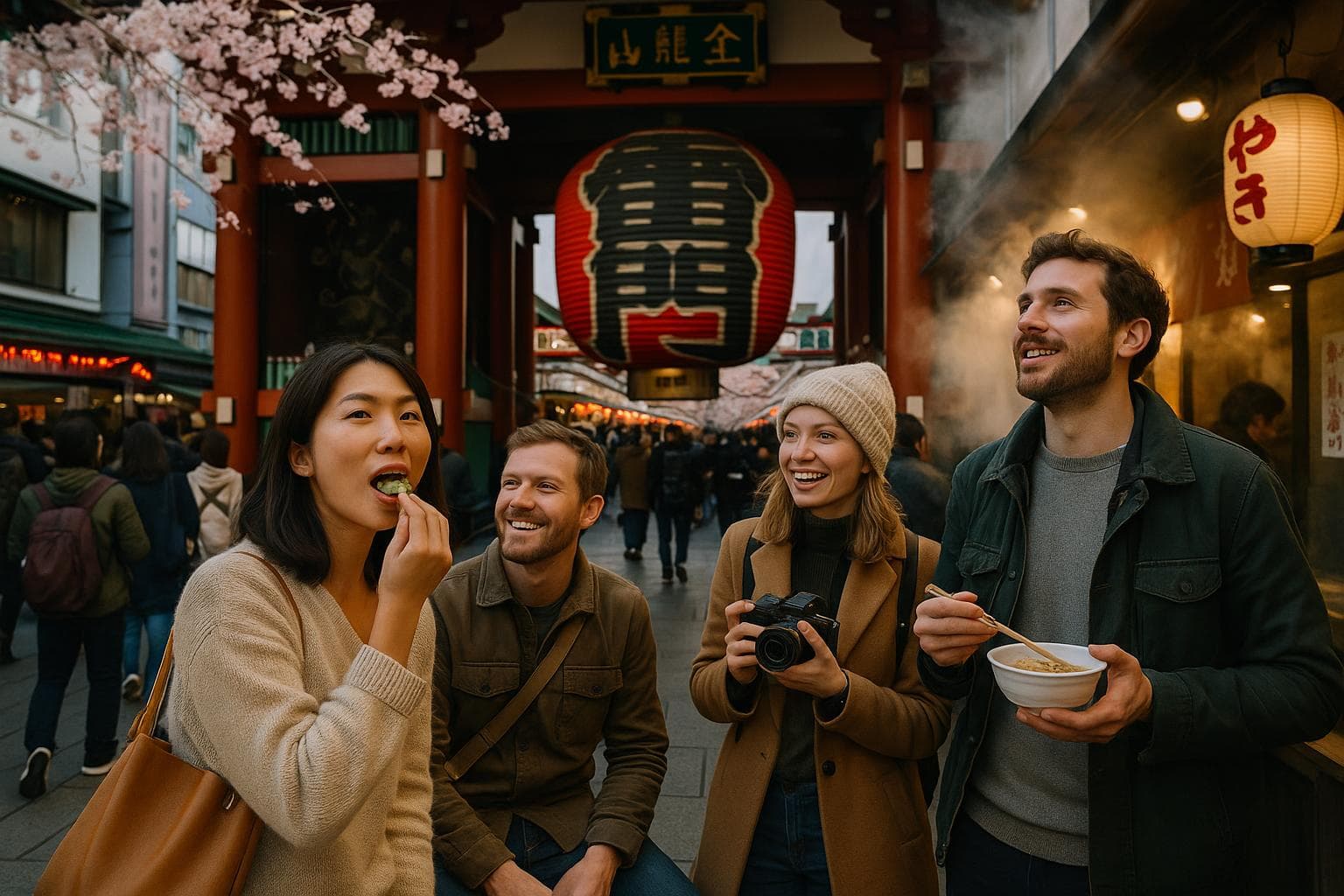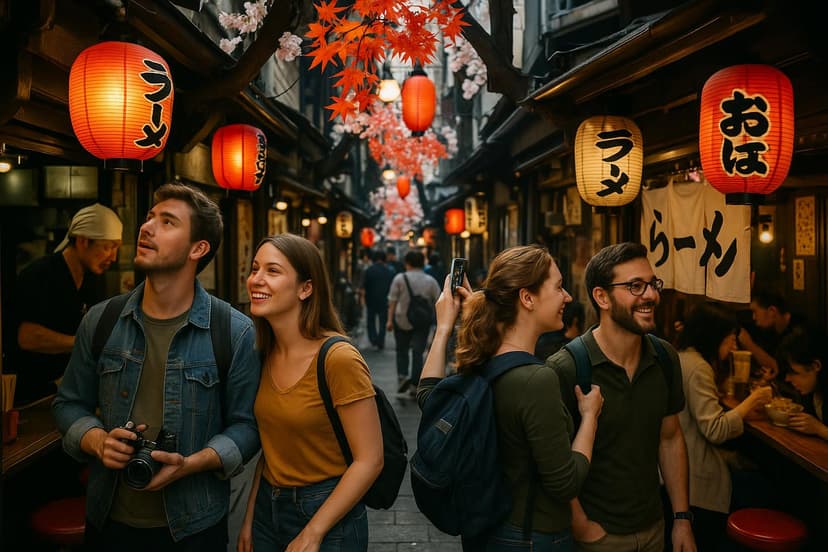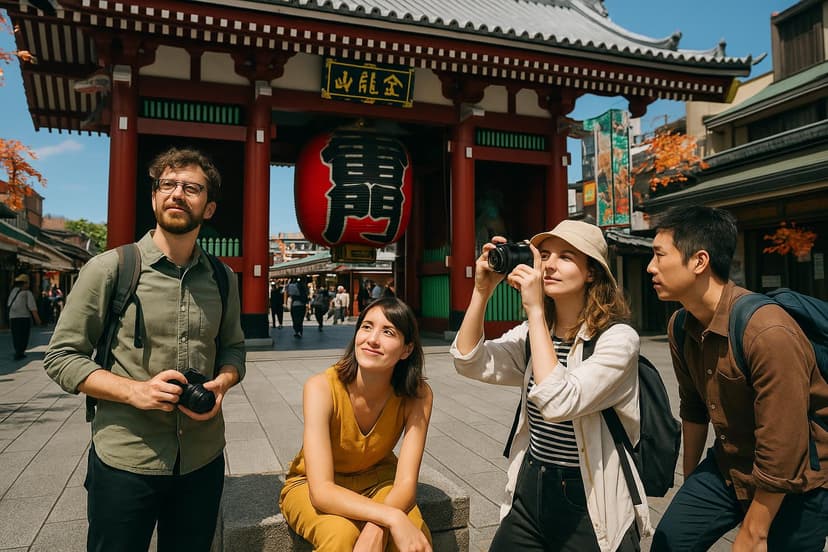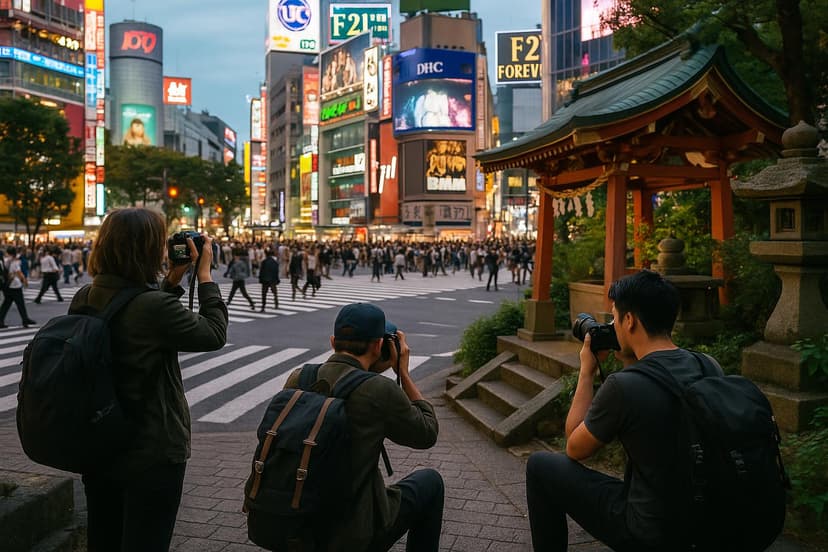Tokyo: Autumn Counter-Seat Omakase, Depachika Grazing & Steam-Filled Ramen Alleys

A 4-day, seasonally tuned culinary itinerary for food lovers in Tokyo (November, Autumn). Combines depachika grazing, counter-seat sushi omakase, market tastings, hands-on sushi skills, and steam-filled ramen alleys—balanced pacing with practical tips for reservations, dietary needs, and shorter daylight hours.
Highlights
- Seasonal autumn seafood (sanma, buri, uni) featured across markets and omakase
- Depachika (department store food halls) tasting and bento-buying strategy
- Counter-seat omakase evenings in Ginza and Shinjuku
- Steam-filled ramen alleys: Omoide Yokocho & Tokyo Ramen Street (Rokurinsha)
- Hands-on sushi workshop and Kappabashi kitchenware street for gear and knives
Itinerary
Day 1
Ease into Tokyo with depachika grazing, a relaxed sushi lunch, autumn foliage stroll, and an atmospheric ramen alley dinner in Shinjuku.
Depachika grazing at Isetan Shinjuku (food hall)
Start with a sensory tour of Isetan’s basement food hall: sample seasonal sweets, hand-roll sushi snacks, and take-home bento ideas (perfect for tasting many small items).
Tips from local experts:
- Look for November chestnut (kuri) sweets and kuri-filled wagashi—ask sellers for the freshly made ones.
- Bring cash (many stalls accept cash only) and a small tote for takeaway purchases; buyers often split items to taste more stalls.
- If you have shellfish allergies, point to a card reading “甲殻類アレルギーです” (I have a shellfish allergy) so stall staff can advise alternatives.
Counter/bench sushi lunch at Sushi no Midori (Shinjuku)
High-quality, counter-seat sushi with generous portions—order a seasonal lunch set to taste autumn fish without a long omakase commitment.
Tips from local experts:
- Ask for the counter seats to watch plating and to request small substitutions for dietary preferences.
- Order the chef’s recommended lunch set (often includes seasonal fish such as sanma or buri in November).
- If avoiding raw shellfish, ask the chef for grilled or marinated seasonal alternatives; the staff are used to special requests.
Stroll Shinjuku Gyoen National Garden — autumn leaves
Short walk and relaxed pace through Shinjuku Gyoen to see November foliage—helps digest and sets a calm tempo before evening.
Tips from local experts:
- Check the park entry time (earlier closure in late November) and prioritize the Japanese garden section for best color.
- Bring a light layer—mornings can be crisp; November daylight is shorter so plan late-afternoon transfers accordingly.
- There are small tea kiosks near the main paths—try a hot sweet bean jelly (oshiruko) if you want a seasonal warm snack.
Early evening tasting crawl in Omoide Yokocho (Memory Lane)
A narrow, atmospheric alley of tiny yakitori and noodle stalls—crawl between counters to sample grilled skewers, small plates, and local spirits.
Tips from local experts:
- Most stalls are tiny and cash-first; order a couple of skewers and share to taste multiple stalls without long waits.
- Respect counter-seat etiquette: keep conversation quiet when chefs are plating, and leave room for next guests.
- If you prefer milder broths or vegetarian options, ask vendors for vegetable skewers or tofu dishes—many stalls can accommodate.
Late-night counter ramen at Ichiran (Shinjuku branch)
Solo counter seats and focused tonkotsu bowls—customize spice and richness; perfect as an indulgent late bite after alley hopping.
Tips from local experts:
- Use the menu ticket machine—have cash ready. Select your broth richness and spice level (medium recommended if unsure).
- Try to go after 20:30 to reduce queue; the solo counter is optimized for quick dining.
- If you avoid pork, skip Ichiran; they’re pork-broth specialists—ask staff for alternative recommendations in the area.
Day 2
Tsukiji market discoveries, Ginza depachika grazing, an afternoon break, and a reserved counter-seat omakase dinner in Ginza—timed for November seasonal fish.
Morning walk and tasting at Tsukiji Outer Market
Sample sashimi slices, grilled seasonal fish (autumn sanma/buri), fresh tamagoyaki, and small seafood snacks while navigating lively market alleys.
Tips from local experts:
- Arrive by 7:30–8:00 to catch the liveliest vendors and the freshest seasonal offerings with smaller crowds.
- Buy single-item portions to taste many stalls rather than full meals; ask vendors for recommended seasonal bites.
- Wear comfortable shoes and be prepared for narrow walking aisles; bring a wet wipe for hands after seafood samples.
Casual sushi lunch at Sushi Zanmai (Tsukiji area)
Reliable, open counter sushi with wide menu—great fallback if top omakase lines are lengthy; try seasonal nigiri sets.
Tips from local experts:
- Sushi Zanmai is more forgiving on waits than tiny omakase counters—request counter seating for chef interaction.
- Order a seasonal nigiri set to taste locally abundant fish like buri (yellowtail) in November.
- Tell staff about any shellfish allergies; they’ll suggest cooked or alternative pieces where possible.
Ginza depachika and patisserie sampling at Mitsukoshi Ginza food hall
Afternoon depachika visit to sample wagashi, seasonal pastries, and select sake bottles—ideal for gifts and tasting small, refined sweets.
Tips from local experts:
- Look for autumn-themed wagashi (kaki/persimmon motifs) and ask for a small sample if available.
- If you want to take back delicate sweets, ask staff for gift-boxing and refrigeration options for transit.
- Try a sake pairing suggestion from the depachika's sake counter to complement savory snacks.
Break: coffee and rest at Café de l'Ambre (Ginza retro coffeehouse)
A restful coffee stop in Ginza—roasted beans and a small, old-school atmosphere to recharge before evening omakase.
Tips from local experts:
- Tell the barista your preferred roast strength—the house has many single-origin, expertly roasted options.
- Use this quieter moment to confirm dinner reservation details and transport time to Ginza (short walk likely).
- If sensitive to caffeine, order a seasonal hot tea or a smaller espresso to preserve dinner appetite.
Reserved counter-seat omakase at Sushi Tokami (Ginza)
Seasonal curated omakase emphasizing aged and perfectly seasoned pieces—booked reservation to guarantee counter experience.
Tips from local experts:
- Reservation is essential—call or book well in advance and confirm any dietary restrictions (e.g., pregnancy, shellfish allergies).
- Trust the chef’s progression: November sets often highlight buri/seasonal oily fish; consider leaving room and skipping heavy sides earlier in the day.
- Ask for the recommended rice seasoning level if you prefer lighter or richer vinegared rice to maximize enjoyment.
Day 3
Asakusa street snacks and temple stroll, Kappabashi shopping for tools and knives, a hands-on sushi workshop, then an iconic tsukemen ramen at Tokyo Ramen Street.
Nakamise-dori snacks and Senso-ji temple walk (Asakusa)
Taste ningyo-yaki, freshly fried senbei, and seasonal street snacks while exploring Asakusa's historic lanes—great for photographing and taste-testing.
Tips from local experts:
- Try warm ningyo-yaki (red bean-filled cakes) fresh from the shop window—perfect for November chill.
- Buy small portions to share so you can sample multiple snacks without filling up before lunch.
- Be mindful of temple etiquette when sampling nearby—stand to the side when eating and avoid blocking pedestrian flow.
Tempura lunch at Tempura Daikokuya (Asakusa classic)
Hearty tempura tendon done properly—crispy batter and seasonal ingredients, a comforting contrast to nigiri-focused days.
Tips from local experts:
- Order the classic tendon to experience the shop’s signature tempura-to-rice ratio; ask about seasonal items included in November.
- Share a small side dish if you want to leave room for the afternoon workshop and the evening ramen.
- If you avoid shellfish, request vegetable-only tempura options—many tempura chefs can prepare a tasty veggie set.
Kappabashi Dougu Street (kitchenware & knives)
Explore Tokyo’s kitchenware street for knives, cookware, and *sampuru* (plastic food models)—perfect for picking a souvenir chef’s knife or useful tools.
Tips from local experts:
- Bring a padded sleeve or request professional packaging for knives—many shops will wrap for safe airline travel.
- Look for blue #1 carbon-steel knives for chefs who want a true edge; staff often speak enough English to advise you.
- If you collect *sampuru*, go to the specialist shops mid-afternoon when they may demonstrate hand-painting techniques.
Hands-on sushi workshop (basic nigiri & roll techniques)
Two-hour practical session to learn rice seasoning, forming nigiri, and a simple maki roll—keeps the itinerary hands-on and culinary-focused.
Tips from local experts:
- Confirm class content and notify instructors of allergies (they can provide cooked alternatives if needed).
- Wear comfortable, washable clothing—rice handling can be slightly messy; bring a small apron if offered.
- Treat the workshop as both technique and tasting—ask chefs about seasonal fish handling in November (e.g., buri care).
Tsukemen at Rokurinsha on Tokyo Ramen Street (Tokyo Station)
Thick, rich dipping broth and al dente noodles—Rokurinsha is iconic for tsukemen and delivers steamy, satisfying bowls perfect for chilly evenings.
Tips from local experts:
- Go slightly after 19:00 to avoid the heaviest rush; buy a meal ticket and be ready for brisk counter service.
- Try the standard tsukemen and adjust the soup-wari (dilute broth) at the end to finish without overwhelming richness.
- If you prefer less intense pork flavor, ask for a lighter broth or try another Tokyo Ramen Street option specializing in clear broths.
Day 4
Nihombashi and Ginza morning depachika sampling and wagashi tasting, relaxed shopping, then an indulgent final Ginza counter-seat sushi dinner to close the trip.
Morning depachika grazing at Takashimaya Nihombashi
Seek seasonal bento, grilled autumn fish specialties, and high-quality pastries for a leisurely morning taste session.
Tips from local experts:
- Ask for recommendations of shelf-stable items if you plan to bring souvenirs home (pickled items travel well).
- Sample seasonal fish preparations—November promotions often spotlight buri and other oily autumn species.
- If you’re limiting gluten, confirm soy-sauce usage on prepared items; many counters can point to gluten-free picks.
Sushi lunch at Sushi no Midori (Ginza branch) — casual counter meal
A final relaxed counter sushi experience to compare regional styles; order a seasonal nigiri set and ask the chef for highlights of the day.
Tips from local experts:
- Order the chef’s seasonal selection to taste November specialties and to compare rice seasoning against earlier meals.
- If traveling with a partner, share pieces so you can sample more varieties without ordering full extra sets.
- Mention any dietary restrictions up front—Ginza chefs will tailor pieces (e.g., grilled instead of raw) where feasible.
Ginza walk and wagashi tasting at Toraya Ginza
Refined wagashi tasting with tea pairing—an elegant way to experience Japanese confectionery craftsmanship and seasonal motifs.
Tips from local experts:
- Order the seasonal wagashi set and match it with the recommended tea for the best balance of sweetness and astringency.
- Ask staff about the seasonal inspiration behind November confections—Toraya often uses chestnut and persimmon motifs.
- If buying as gifts, request traditional wrapping; the shop will help choose confections that travel well.
Break / pack and light rest at Ginza (hotel or café)
An intentionally light break to pack purchases, rest before dinner, and confirm transport logistics for departure (shorter daylight in November).
Tips from local experts:
- Use this time to refrigerate perishable purchases or request temporary hotel storage if needed for later collection.
- Confirm dinner reservation time and transit to airport if leaving the next day—allow extra time for busy evening trains.
- If you have evening flights, plan your final meal with earlier seating to avoid rushing; November trains can be packed after 18:00.
Final indulgent counter-seat omakase at Ginza Kyubey
A memorable finale—Kyubey’s counter seats and seasonal omakase focus on perfect slicing, rice balance, and presentation.
Tips from local experts:
- Confirm reservation and any dietary restrictions at least 48 hours in advance; discuss any allergies to ensure a safe, tailored menu.
- Ask the chef about November highlights—you may get prized seasonal pieces that are only available for a short window.
- Savor the progression slowly—avoid strong palate-cleansing items right before the last course to fully appreciate finishing pieces.



